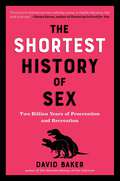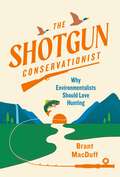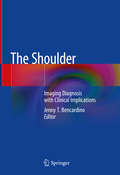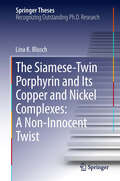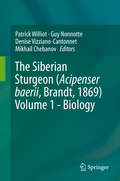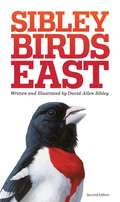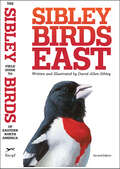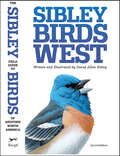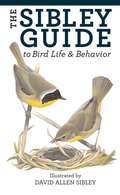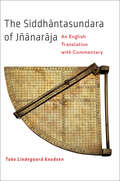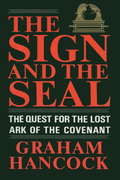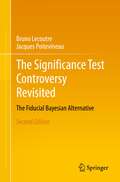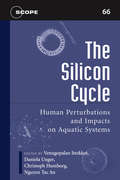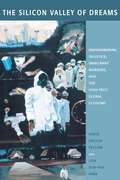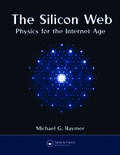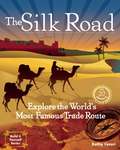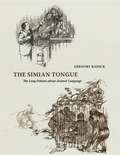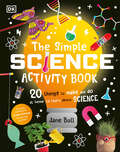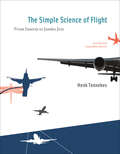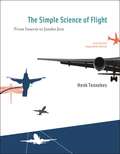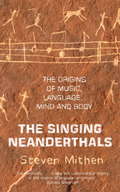- Table View
- List View
The Shortest History of Sex: Two Billion Years Of Procreation And Recreation (Shortest History #0)
by David BakerA wild—and satisfying!—ride through two billion years of sexual evolution. The Shortest History books deliver thousands of years of history in one riveting, fast-paced read. From the first microbial exchanges of DNA to Tinder and sexbots, how did sex begin, and how did it evolve to be so varied and complex in humans? What influence do our genetic ancestors have on our current love lives? And what might sex look like in the future? With acuity, humor, and respect for human diversity, The Shortest History of Sex reveals where the many facets of our sexuality—chemical, anatomical, behavioral, social—come from. Chasing down our evolutionary family tree, from the first aquatic creatures to primate societies, David Baker sheds light on our baffling array of passions, impulses, and fetishes, and guides us toward a clear understanding of one of the deepest, most abiding forces of human nature. The Shortest History of Sex also charts how sex changed for humans across the foraging, agrarian, and modern eras, showing how, even as our biology and sexual instincts have remained the same, the current nature of our sex lives has no historical or evolutionary precedent. The result is a revealing, utterly unique insight into history and human behavior—and the profound forces of nature and nurture compelling our most intimate relationships.
The Shortest History of the Dinosaurs: The 230-Million-Year Story of Their Time on Earth (The Shortest History Series)
by Riley BlackA highlight-reel history of the dinosaurs, told like never before—bringing their world to vivid life in a paleontological detective story The Shortest History of the Dinosaurs tells the 230-million-year epic of these staggeringly fascinating prehistoric creatures, covering their small beginnings, spectacular golden periods, and stunning evolutionary success—before an unthinkable asteroid event brought everything to a screeching halt. But this history digs deeper, using numerous recent fossil discoveries and fresh understandings of genetics and evolution to show how we’ve gleaned so much about a long-lost world from mere fragments of fossil. Marshaling the evidence, award-winning author Riley Black reveals the startling relationships that dinosaurs shared with one another, the land they lived on, and other animal species. By conjuring a more complete picture of Earth in the age of the dinosaurs, she shows us how these massive monsters owe their rise to luck as much as to their cunning—and the many surprising ways they left an indelible mark on their dramatically changing world.
The Shotgun Conservationist: Why Environmentalists Should Love Hunting
by Brant MacDuffAt the intersection of hunting and conservation, a man shares his personal journey from staunch anti-hunter to compassionate, ethical hunter, weaving together a larger history of humans, animals, the environment, and our food systems.The Shotgun Conservationist doesn&’t teach us how to hunt, it explores why we should hunt. As public lands remain imperiled, factory farms pollute the earth and subject animals to inhumane conditions, and global uncertainty presses us all to be more self-sufficient, there has never been a better time to take up hunting. Writer, natural historian, and public speaker Brant MacDuff has done just that. An avid animal lover and raised as a non-hunter, MacDuff started his journey intending to investigate the claim that &“hunting is conservation.&” So convinced, he now holds a hunting license in four states and gives lectures on the positive impact it has on conservation efforts nationwide. Armed with years of experience in the field and a deep love for the natural world, MacDuff tells the provocative, humorous, and insightful story of how he became a hunter. Along the way, readers meet a cast of colorful characters and learn the firsthand research that helped change Brant&’s mind. You may not book a hunting trip after reading The Shotgun Conservationist, but you&’ll have a new perspective on and appreciation for those that do.
The Shoulder: Imaging Diagnosis with Clinical Implications (The\clinics: Radiology Ser. #20-2)
by Jenny T. BencardinoThis book covers all aspects of imaging diagnosis of shoulder disorders from a clinical perspective. After discussion of relevant imaging techniques, a wide spectrum of disorders is addressed in a series of dedicated chapters on rotator cuff injuries and impingement syndromes, biceps tendon and rotator interval pathology, glenohumeral instability, SLAP tears and microinstability, shoulder girdle fractures, shoulder arthropathies, tumors and tumor-like conditions, and entrapment neuropathies. Separate consideration is also given to the pediatric shoulder and to preoperative planning, postoperative imaging, and surgical techniques in patients undergoing shoulder arthroplasty.The unique anatomy and range of motion of the shoulder joint can present a diagnostic challenge. Characterization of soft tissue injuries and radiographically occult osseous pathology is often facilitated by the use of advanced imaging techniques, including MRI, CT, and ultrasound. Readers will find this excellently illustrated book to be an invaluable aid to diagnostic interpretation when employing these techniques.
The Siamese-Twin Porphyrin and Its Copper and Nickel Complexes: A Non-Innocent Twist
by Lina K. BluschThis thesis describes the first and long-sought successful synthesis of a new pyrazole-expanded porphyrin, a higher analog of porphyrin. This "Siamese-Twin Porphyrin" provides two conjoined porphyrin-like coordination spheres, thus being able to accommodate two metal ions within the same ligand. In her thesis, Lina Blusch not only explains the challenging synthesis and characterization of the ligand system, but also its application to the synthesis of homo- and hetero-bimetallic Ni and Cu complexes. She observes interesting metal-metal-interactions in the complexes, that lead to a non-innocent multistep redox chemistry. The ligand system and its complexes show an intriguing twisted geometry, giving rise to helical chirality and other fascinating properties. This study explores the first steps and opens up a new chemistry of expanded porphyrins with the potential to biomimetic applications.
The Siberian Sturgeon (Acipenser baerii, Brandt, 1869) Volume 1 - Biology
by Patrick Williot Guy Nonnotte Denise Vizziano-Cantonnet Mikhail ChebanovThe biology of the Siberian sturgeon, Acipenser baerii Brandt 1869, has become a very attractive subject of investigation for biologists since the 1980s. This volume 1 is part of a two-volume set devoted to the species, the second of which focuses on farming. The present volume is divided into three parts: Biology and ecology, Biology and physiology of reproduction, and Ecophysiology, i.e. adaptation to the environment. The first part addresses a broad range of topics, such as: the ecology, including a new approach to species-specificity, a new insight on the mineralization of vertebral elements, two approaches to sex determination, transposable elements in the gonads, early ontogeny, olfaction and gustation, nutrition and swimming. The second part includes neurochemical and anatomical descriptions of the central nervous system and an updated version of the oogenesis, the characteristics of both sperm and spermatozoa, and a synthesis on gonadal steroids (synthesis, plasmatic levels and biological activities). In turn, the third part reveals how the physiology of the species changes depending on environmental factors such as oxygen, ammonia, and nitrite. Some fundamental consequences of ammonia are developed (sublethal and lethal levels, effects on gill epithelium and haematology, acid-base balance, on AA and adenyl nucleotides levels in plasma, brain and muscle tissue). In addition, the book includes two methodological chapters dealing with fish dorsal aortic cannulation and respiration physiology.
The Siberian Sturgeon (Acipenser baerii, Brandt, 1869) Volume 2 - Farming
by Patrick Williot Guy Nonnotte Mikhail ChebanovThe Siberian sturgeon, Acipenser baerii Brandt 1869 is the most widely farmed sturgeon species. Continuing from Volume 1, which focuses on the biology of the species, the present Volume 2 in turn examines farming aspects. It is divided into six parts, the first of which deals with reproduction and early ontogenesis, i.e. reproductive cycles, controlled reproduction, sperm cryoconservation, and weaning of larvae. The second covers the growing phase with a focus on food and feeding (management, fish meal replacement, potential endocrine disruptions, usefulness of prebiotics and immunostimulants, and nitrogen excretion). Production-related data are the focus of the third part and include: characteristics (countries, structures of production, evolution in production, economic features) of the gross production of the species (meat and caviar) worldwide, a method for assessing the quality of caviars, off-flavors management, and an example of production of fingerlings for restocking. Part four addresses selected long-term management issues: genetic variability of brood stocks, genome manipulation and sex control, and the advantages of hybrids. The next three chapters constitute the fifth part, which is devoted to health status (immunology and welfare). In closing, the absence of ecological risks of introducing the species in non-native waters is shown using two long-term documented examples (Russia and France). Three methodological chapters round out the volume, covering: in vitro incubation of ovarian follicles, a richly illustrated library of echographies and photos, and a detailed presentation of oxygen demand studies.
The Sibley Field Guide To Birds Of Eastern North America: Second Edition
by David SibleyThe Sibley Guide to Birds has quickly become the new standard of excellence in bird identification guides, covering more than 810 North American birds in amazing detail. Now comes a new portable guide from David Sibley that every birder will want to carry into the field. Compact and comprehensive, this new guide features 650 bird species plus regional populations found east of the Rocky Mountains. Accounts include stunningly accurate illustrations—more than 4,200 in total—with descriptive caption text pointing out the most important field marks. Each entry contains new text concerning frequency, nesting, behavior, food and feeding, voice description, and key identification features. Accounts also include brand-new maps created from information contributed by 110 regional experts across the continent.
The Sibley Field Guide to Birds of Eastern North America: Second Edition
by David Allen SibleyCOMPLETELY REVISED AND UPDATED: Perfect for the field! The most authoritative on-the-go guide to the birds of the East • From renowned birder, illustrator, and New York Times best-selling author David SibleyCompact and comprehensive, this guide features 650 bird species, plus regional populations, found east of the Rocky Mountains. Entries include stunningly accurate illustrations—more than 4,600 in total—with descriptive captions pointing out the most important field marks. Each entry has been updated to include the most current information concerning frequency, nesting, behavior, food and feeding, voice description, and key identification features. Here too are more than 600 updated maps drawn from information contributed by 110 regional experts across the continent, and showing winter, summer, year-round, migration, and rare ranges.This revised edition includes:• Updated habitat, description, behavior, and conservation text for each species account and all family pages.• New and revised illustrations of species and regional forms.• New design featuring species accounts in columns, allowing for better comparison and more illustrations and text. • Current taxonomic order and up-to-date common names. • All maps revised to reflect the most current range information. • More species and rarities included
The Sibley Field Guide to Birds of Western North America: Second Edition
by David Allen SibleyThe Sibley Guide to Birds has quickly become the new standard of excellence in bird identification guides, covering more than 810 North American birds in amazing detail. Now comes a new portable guide from David Sibley that every birder will want to carry into the field. Compact and comprehensive, this new guide features 703 bird species plus regional populations found west of the Rocky Mountains. Accounts include stunningly accurate illustrations—more than 4,600 in total—with descriptive caption text pointing out the most important field marks. Each entry contains new text concerning frequency, nesting, behavior, food and feeding, voice description, and key identification features. Accounts also include brand-new maps created from information contributed by 110 regional experts across the continent. The Sibley Field Guide to Birds of Western North America is an indispensable resource for all birders seeking an authoritative and portable guide to the birds of the West.
The Sibley Guide to Bird Life and Behavior
by David Allen SibleyDesigned to enhance the birding experience and to enrich the popular study of North American birds, this landmark book includes authoritative texts by 48 expert birders and biologists.
The Sibling Relationship After Acquired Brain Injury: Family Dynamics Across the Lifespan (After Brain Injury: Survivor Stories)
by Penelope AnalytisThis important book gives a voice to the lived experience of siblings and family members when one sibling has an acquired brain injury (ABI). ABI is associated with a range of physical, cognitive, behavioural and personality changes, many of which will be lifelong. Penelope Analytis examines how this condition affects the sibling relationship. Although siblings play an important role in our sense of identity, development and wellbeing, this relationship has been largely overlooked in the context of rehabilitation. Combining research with stories of siblings’ experiences of life after ABI, this book explores how siblings seek to continue their relationship across the lifespan and make sense of the impact of ABI. It looks at the concept of "post-traumatic growth" within the context of ABI and explores siblings’ perceptions of growth after ABI, including shaping their life priorities, family relationships and values. It includes the perspectives of siblings themselves who have an ABI, recognising them as active members of this unique relationship, and of siblings of people with an ABI. This is valuable reading for siblings and families impacted by ABI and professionals working with them who would like to better understand how to support siblings, as well as students in neuropsychology and related fields.
The Siddhāntasundara of Jñānarāja: An English Translation with Commentary
by Toke Lindegaard KnudsenThe first English translation of this major work of classical Indian astronomy and mathematics.A treasure for anyone interested in early modern India and the history of mathematics, this first English translation of the Siddhāntasundara reveals the fascinating work of the scholar-astronomer Jñānarāja (circa 1500 C.E.). Toke Lindegaard Knudsen begins with an introduction to the traditions of ancient Hindu astronomy and describes what is known of Jñānarāja’s life and family. He translates the Sanskrit verses into English and offers expert commentary on the style and substance of Jñānarāja's treatise.The Siddhāntasundara contains a comprehensive exposition of the system of Indian astronomy, including how to compute planetary positions and eclipses. It also explores deep, probing questions about the workings of the universe and sacred Hindu traditions. In a philosophical discussion, the treatise seeks a synthesis between the cosmological model used by the Indian astronomical tradition and the cosmology of a class of texts sacred in Hinduism. In his discourse, which includes a discussion of the direction of down and adhesive antipodeans, Jñānarāja rejects certain principles from the astronomical tradition and reinterprets principles from the sacred texts. He also constructs a complex poem on the seasons, many verses of which have two layers of meaning, one describing a season, the other a god's activities in that season. The Siddhāntasundara is the last major treatise of Indian astronomy and cosmology to receive serious scholarly attention, Knudsen’s careful effort unveils the 500-year-old Sanskrit verses and shows the clever quirkiness of Jñānarāja's writing style, his keen use of mathematics, and his subtle philosophical arguments.
The Sign and the Seal
by Graham HancockThe fact of the Lost Ark of the Covenant is one of the grant historical mysteries of all time. To believers, the Ark is the legendary vesel holding the stone tablets of the Ten Commandments. The Bible contains hundreds of references to the Ark's power to level mountains, destroy armies, and lay waste to cities. The Ark itself, however, mysteriously disappears from recorded history sometime after the building of the Temple of Solomon. After ten years of searching through the dusty archives of Europe and the Middle East, as well as braving the real-life dangers of a bloody civil war in Ethiopia, Graham Hancock has succeeded where scores of others have failed. This intrepid journalist has tracked down the true story behind the myths and legends -- revealing where the Ark is today, how it got there, and why it remains hidden. Part fascinating scholarship and part entertaining adventure yarn, tying together some of the most intriguing tales of all time -- from the Knights Templar and Prester John to Parsival and the Holy Grail -- this book will appeal to anyone fascinated by the revelation of hidden truths, the discovery of secret mysteries.
The Significance Test Controversy Revisited: The Fiducial Bayesian Alternative
by Bruno Lecoutre Jacques PoitevineauThis book explains the misuses and abuses of Null Hypothesis Significance Tests, which are reconsidered in light of Jeffreys’ Bayesian concept of the role of statistical inference, in experimental investigations. Minimizing the technical aspects, the studies focuses mainly on methodological contributions. The first part of the book gives an overview of the major approaches to statistical testing and an enlightening discussion of the philosophies of Fisher, Neyman-Pearson and Jeffrey. The conceptual and methodological implications of current practices of reporting effect sizes and confidence intervals are also examined and challenged. This sheds new light on the "significance testing controversy" and provides an appropriate Bayesian framework for a comprehensive approach to the analysis and interpretation of experimental data. The second part of the book provides concrete Bayesian routine procedures that bypass common misuses of significance testing and are readily applicable in a wide range of real applications. This approach addresses the need for objective reporting of experimental data, that is acceptable to the scientific community. This is emphasized by the name fiducial (from the Latin fiducia = confidence). The fiducial Bayesian procedures provide the reader with a real opportunity to think sensibly about problems of statistical inference. This book prepares students and researchers to critically read statistical analyses reported in the literature and equips them with an appropriate alternative to the use of significance testing.
The Silent Wastewater Problem in Sub-Saharan Africa (SpringerBriefs in Water Science and Technology)
by Joan Nyika Megersa Olumana DinkaThis book seeks to explore the critical but very influential challenge of wastewater management from a global perspective and to specifics in SSA region where the subject is under researched. The book will detail on the production trends, the treatment approaches used currently and those proposed in a circular economy among other management approaches that can enhance sustainable wastewater management while prioritizing reuse and recovery of the resource. The book is a need of the hour since only a few studies have addressed the production trends and management of wastewater in SSA region as Onu et al. (2023) noted. The aim is to close the research gap and infuse theory from successful case studies of other regions of the world into practice in SSA. Ultimately, with sustainable wastewater management, access to safe water and sanitation can be enhanced in line with realization of sustainable development goal (SDG) 6. The book will be useful to environmental pollution regulators, researchers, and practitioners among other stakeholders with a role in wastewater treatment and management.
The Silicon Cycle: Human Perturbations and Impacts on Aquatic Systems (SCOPE Series #66)
by Daniela Unger Nguyen Tac An Venugopalan Ittekkot Christoph HumborgSilicon is among the most abundant elements on earth. It plays a key but largely unappreciated role in many biogeochemical processes, including those that regulate climate and undergird marine food webs. The Silicon Cycle is the first book in more than 20 years to present a comprehensive overview of the silicon cycle and issues associated with it. The book summarizes the major outcomes of the project Land-Ocean Interactions: Silica Cycle, initiated by the Scientific Community on Problems of the Environment (SCOPE) of the International Council of Scientific Unions (ICSU). It tracks the pathway of silicon from land to sea and discusses its biotic and abiotic modifications in transit as well as its cycling in the coastal seas. Natural geological processes in combination with atmospheric and hydrological processes are discussed, as well as human perturbations of the natural controls of the silicon cycle.
The Silicon Valley of Dreams: Environmental Injustice, Immigrant Workers, and the High-Tech Global Economy (Critical America #31)
by David Pellow Lisa Sun-Hee ParkExamines the environmental racism at the foundation of the Silicon Valley economyNext to the nuclear industry, the largest producer of contaminants in the air, land, and water is the electronics industry. Silicon Valley hosts the highest density of Superfund sites anywhere in the nation and leads the country in the number of temporary workers per capita and in workforce gender inequities. Silicon Valley offers a sobering illustration of environmental inequality and other problems that are increasingly linked to the globalization of the world's economies. In The Silicon Valley of Dreams, the authors take a hard look at the high-tech region of Silicon Valley to examine environmental racism within the context of immigrant patterns, labor markets, and the historical patterns of colonialism. One cannot understand Silicon Valley or the high-tech global economy in general, they contend, without also understanding the role people of color play in the labor force, working in the electronic industry's toxic environments. These toxic work environments produce chemical pollution that, in turn, disrupts the ecosystems of surrounding communities inhabited by people of color and immigrants. The authors trace the origins of this exploitation and provide a new understanding of the present-day struggles for occupational health and safety. The Silicon Valley of Dreams will be critical reading for students and scholars in ethnic studies, immigration, urban studies, gender studies, social movements, and the environment, as well as activists and policy-makers working to address the needs of workers, communities, and industry.
The Silicon Web: Physics for the Internet Age
by Michael G. RaymerThe technology behind computers, fiber optics, and networks did not originate in the minds of engineers attempting to build an Internet. The Internet is a culmination of intellectual work by thousands of minds spanning hundreds of years. We have built concept upon concept and technology upon technology to arrive at where we are today, in a world co
The Silk Road
by Kathy CeceriFrom Roman times until the Age of Exploration, the Silk Road carried goods and ideas across Central Asia between two major centers of civilization, the Mediterranean Sea and China. In The Silk Road: Explore the World's Most Famous Trade Route, readers ages 9-12 will learn about the history, geography, culture, and people of the Silk Road region.Marco Polo was just one of many who set out on the Silk Road in search of wealth, power, or knowledge. These adventurers braved vast deserts, towering mountain peaks, warring tribes, and marauding bandits. Silk garments, wool rugs, and fine glass were the prizes for those who survived the trip. Activities using everyday materials bring the Silk Road to life. Young readers will see how ideas in math, science, religion, and art were spread by travelers along with the treasures they found.The Silk Road takes readers on an exciting, interactive adventure to a faraway place and celebrates its important role in human history and development..
The Simian Tongue: The Long Debate about Animal Language
by Gregory RadickIn the early 1890s the theory of evolution gained an unexpected ally: the Edison phonograph. An amateur scientist used the new machine—one of the technological wonders of the age—to record monkey calls, play them back to the monkeys, and watch their reactions. From these soon-famous experiments he judged that he had discovered “the simian tongue,” made up of words he was beginning to translate, and containing the rudiments from which human language evolved. Yet for most of the next century, the simian tongue and the means for its study existed at the scientific periphery. Both returned to great acclaim only in the early 1980s, after a team of ethologists announced that experimental playback showed certain African monkeys to have rudimentarily meaningful calls. Drawing on newly discovered archival sources and interviews with key scientists, Gregory Radick here reconstructs the remarkable trajectory of a technique invented and reinvented to listen in on primate communication. Richly documented and powerfully argued, The Simian Tongue charts the scientific controversies over the evolution of language from Darwin’s day to our own, resurrecting the forgotten debts of psychology, anthropology, and other behavioral sciences to the Victorian debate about the animal roots of human language.
The Simple Science Activity Book: 20 Things to Make and Do at Home to Learn About Science
by Jane BullLittle crafters will become little scientists as they explore, experiment, make, and create their way through every STEAM project.Learn through play with this hands-on crafty science book that introduces inquisitive children to the wonders of science through craft projects with everyday objects.The Simple Science Activity Book contains more than 20 fun-filled craft projects, each accompanied by a &‘What&’s the science?&’ section explaining how key scientific concepts work. Children can enjoy getting stuck in and learn how to make a toy raft and discover what makes their boat float, or how to create an ice sculpture and learn about the changing states of solids and liquids. They&’ll discover the world around them like they&’ve never seen it before!This hands-on science activity book for children offers: - Over 20 activities that are easy for children aged 5-7 to do on their own, with only a handful of steps requiring an adult to help.- A range of different projects, including art, photography, crafts, cooking, and gardening, all using everyday objects found in and around the home.- An introduction to key skills like problem-solving, observation, and hands-on learning through fun scientific experiments. With The Simple Science Activity Book, difficult concepts like buoyancy, gravity, and aerodynamics become meaningful and accessible to young children through play. Award-winning author Jane Bull combines art, craft, and cooking activities with solid scientific learning, showing children that science, technology, engineering, art, and maths are all around us – and in everything we make and do!
The Simple Science of Flight, revised and expanded edition: From Insects to Jumbo Jets
by Henk TennekesAn investigation into how machines and living creatures fly, and of the similarities between butterflies and Boeings, paper airplanes and plovers.From the smallest gnat to the largest aircraft, all things that fly obey the same aerodynamic principles. In The Simple Science of Flight, Henk Tennekes investigates just how machines and creatures fly: what size wings they need, how much energy is required for their journeys, how they cross deserts and oceans, how they take off, climb, and soar. Fascinated by the similarities between nature and technology, Tennekes offers an introduction to flight that teaches by association. Swans and Boeings differ in numerous ways, but they follow the same aerodynamic principles. Biological evolution and its technical counterpart exhibit exciting parallels. What makes some airplanes successful and others misfits? Why does the Boeing 747 endure but the Concorde now seem a fluke? Tennekes explains the science of flight through comparisons, examples, equations, and anecdotes. The new edition of this popular book has been thoroughly revised and much expanded. Highlights of the new material include a description of the incredible performance of bar-tailed godwits (7,000 miles nonstop from Alaska to New Zealand), an analysis of the convergence of modern jetliners (from both Boeing and Airbus), a discussion of the metabolization of energy featuring Lance Armstrong, a novel treatment of the aerodynamics of drag and trailing vortices, and an emphasis throughout on evolution, in nature and in engineering. Tennekes draws on new evidence on bird migration, new wind-tunnel studies, and data on new airliners. And his analysis of the relative efficiency of planes, trains, and automobiles is newly relevant. (On a cost-per-seat scale, a 747 is more efficient than a passenger car.)
The Simple Science of Flight: From Insects to Jumbo Jets (Revised and Expanded Edition)
by Henk TennekesFrom the smallest gnat to the largest aircraft, all things that fly obey the same aerodynamic principles. In The Simple Science of Flight, Henk Tennekes investigates just how machines and creatures fly: what size wings they need, how much energy is required for their journeys, how they cross deserts and oceans, how they take off, climb, and soar. Fascinated by the similarities between nature and technology, Tennekes offers an introduction to flight that teaches by association. Swans and Boeings differ in numerous ways, but they follow the same aerodynamic principles. Biological evolution and its technical counterpart exhibit exciting parallels. What makes some airplanes successful and others misfits? Why does the Boeing 747 endure but the Concorde now seem a fluke? Tennekes explains the science of flight through comparisons, examples, equations, and anecdotes. The new edition of this popular book has been thoroughly revised and much expanded. Highlights of the new material include a description of the incredible performance of bar-tailed godwits (7,000 miles nonstop from Alaska to New Zealand), an analysis of the convergence of modern jetliners (from both Boeing and Airbus), a discussion of the metabolization of energy featuring Lance Armstrong, a novel treatment of the aerodynamics of drag and trailing vortices, and an emphasis throughout on evolution, in nature and in engineering. Tennekes draws on new evidence on bird migration, new wind-tunnel studies, and data on new airliners. And his analysis of the relative efficiency of planes, trains, and automobiles is newly relevant. (On a cost-per-seat scale, a 747 is more efficient than a passenger car.)
The Singing Neanderthals: The Origins of Music, Language, Mind and Body
by Prof Steven MithenA fascinating and incisive examination of our language instinct from award-winning science writer Steven Mithen.Along with the concepts of consciousness and intelligence, our capacity for language sits right at the core of what makes us human. But while the evolutionary origins of language have provoked speculation and impassioned debate, music has been neglected if not ignored. Like language it is a universal feature of human culture, one that is a permanent fixture in our daily lives.In THE SINGING NEANDERTHALS, Steven Mithen redresses the balance, drawing on a huge range of sources, from neurological case studies through child psychology and the communication systems of non-human primates to the latest paleoarchaeological evidence.The result is a fascinating and provocative work and a succinct riposte to those, like Steven Pinker, who have dismissed music as a functionless and unimportant evolutionary byproduct.
